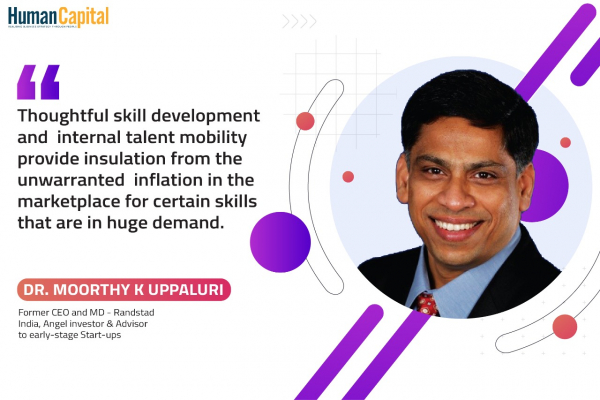A culture where successes are rewarded, and failures not penalised but treated as valuable learnings, is essential for the success of the talent that is mobilised internally.
Deciding whether to hire internally or to bring in ‘new blood’ constitutes the critical first step that reflects the leadership’s mindset and the organisational culture as it pertains to internal talent mobility.
• Does new talent always usher in fresh thinking and innovation?
• Is there a common misperception that internal talent, despite having historical knowledge and valuable domain expertise, cannot drive the necessary innovation or transformation?
• On the contrary, would not the new talent take time to understand the new market, products, processes, customer preferences, value proposition, and figure out a way forward?
Along this journey, there is bound to be some collateral damage - unintended erosion of talent. And yet, some companies pay a premium to poach talent from their competition and then invest further to create ‘me too’ kind of offerings.
• Do companies have a bias against the internal talent that is right under their nose?
• Does the cliché ‘familiarity breeds contempt’ hold true in this case?
• Is it in vogue to lose talent that has been with the company for a long time due to sheer negligence and under the pretext of disruptive transformation?
• Can it be systematically and objectively determined when a given role cannot be filled internally and must be filled with external talent?
• Does the team need an infusion of external talent to question the status quo or when it is losing the ability to challenge while slowly succumbing to the silently creeping Abilene paradox?
Just as it takes a ‘diamond expert’ to identify a real diamond it takes a ‘talent expert’ to identify and nurture real talent. An Expert not only has an eye for talent but values it and has tremendous respect for it. Mobility is a fundamental human right, and independent mobility is what enables us to explore, learn, socialise, and engage with one another. Mobility is indeed a characteristic of life, and that applies to talent and careers as well. Employees quite often seek upward mobility or elevation in their roles and organisational hierarchy in the name of promotion. Lateral movements are equally important to broaden the employees’ perspective and expand their horizon to get them ready for bigger roles. Like a tiger that steps back before it leaps forward, employees may have to take on lateral assignments to gain experiences and skills that will prepare them for bigger and bolder roles ahead.
Mobility of talent
Mobility of talent within a business or company can either be initiated or volunteered by the employee or be suggested or solicited by the organisation. It is mutually beneficial - both in serving the purpose of the company and in developing the employee holistically. Engaging talent mobility means leveraging the capabilities of the team always, filling critical gaps quickly and easily, and optimising the overall success of the company.
Manager’s mindset to both export and import talent is critical to foster internal talent mobility. It is possible for employees to build bonds and emotional ties with their managers. Such bonds get strengthened over time and make it difficult for the manager to let go of such talent, even if it is in the best interests of the overall business or the team member. HR, along with the top leadership, must be the custodian of the organisational talent, so that it can be the catalyst enabling mobility and guarding against such personal bias. Employees take up challenging expat assignments with substantial risk - far away from their homeland and loved ones to demonstrate their commitment to the company/career and prove their capability. It is extremely critical to create a fail-safe environment where employees can take on new roles with high risk, give it their best shot and not be penalised in case they fail. A culture where successes are rewarded, and failures are not penalised but treated as valuable learnings is essential for the success of the talent that is mobilised internally.
The challenges imposed on businesses due to the VUCA environment are further aggravated by the technology disruption and the pandemic. Being strategic with talent mobility can be a win-win proposition during these times. It is all about taking the time to account for the employees’ skills and competencies (baseline - skill inventory), and then aligning their assignments (jobs, projects, or gigs) with both their short and long-term career aspirations. Mobilising the talent to those assignments that best leverage their capabilities and develop them will not only yield the best results for the business, but also keep the employees engaged with a high sense of gratification. Both upskilling and reskilling of the employees is an integral part of the talent development initiative. This will also help with the retention of talent, and reduction in recruitment and training costs.
Career paths and skilling plans
Just like career paths and skilling plans for individuals/employees, organisations must have talent roadmaps that describe the current state of the organisational talent, gaps in talent and future demands that must be addressed. This can be done by either acquiring or developing the required talent along a well-defined timeline to support the organisation in achieving the business results that it has set out to achieve in a predictable manner. Building a talent roadmap that is aligned with business plan/outcomes on one hand, and is well-integrated with the employee skills and career aspirations on the other hand, is clearly the way forward.
Several folks seeking employment in the current market are either unskilled or underskilled, thus resulting in either unemployment or underemployment. Internal talent can adapt quickly to the shift in the business environment and contribute effectively. Every time I had an opportunity to place my bets on internal talent, even if the talent was not fully ready, I took a chance, and they were often successful! Such success is gratifying as it inspires them and boosts their self-confidence. As a result, they renew their commitment to the company and the leadership that provided them with that opportunity. This apart, I have seen them making similar bets on internal talent and spread that culture of creating such opportunities to mobilise internal talent and celebrating the success of internal talent. Success breeds success!
Talent slated for succession
Large and mature organisations maintain a list of such high-potential internal talent that is slated for succession to critical leadership roles as and when required. Such strategic thinking and long-term approach to talent create a resilient organisation that could weather unplanned turbulence associated with any unwarranted attrition. Elevation of internal talent to the helm is not only construed as good planning but is also supported and appreciated by the internal teams. Teams are inspired by such movements, and as a result, demonstrate improved levels of engagement and commitment. Such announcements are also construed by the Street and Markets as strategic decisions that foster stability and predictable business performance.
The talent market is more competitive now than ever before, with a whole new set of skills shaping the demands of the future workforce. Identifying the skill/talent gap ahead of time allows adequate time for the recruiting teams to acquire the talent to support the business needs on time. Unforeseen and unfulfilled demand for talent inflates the cost of acquisition and results in missed opportunities. Talent mobility also allows the recruitment team to focus on those truly hard-to-fill positions. Organisations must develop a talent roadmap to successfully bridge this huge gap and navigate this critical transition. Thoughtful skill development and internal talent mobility provide insulation from the unwarranted inflation in the marketplace for certain skills that are in huge demand.
The war for talent
The war for talent is becoming too intense, and hence, cannot be ignored. Engaging the talent in the organisation effectively and focusing on further development is tantamount to building a strong feeder pool of talent for the next generation of leaders. Most employees are open and keen to hear about internal career opportunities. If those opportunities do not come from within or they do not have equitable access to such opportunities, they are most likely to pursue them externally, resulting in unwarranted attrition that comes with increased recruiting and training costs.
Consistent talent calibration across the organisation is the foundation to enable and foster internal talent mobility. The performance appraisal systems must ensure objective evaluations, remain consistent, be transparent, credible and well-calibrated across different cultures and managers. When this is not the case, the assessment of both performance and potential will be suspect and allegedly be considered subjective. Openness in culture, meritocracy, and democratisation of career paths are essential building blocks that facilitate friction-free mobility of talent internally. There is nothing like an optimal career path and one proven path for success. After mapping and comparing several successful careers across teams, organisations, and businesses, it became apparent that there is nothing in common across any two successful career paths. Successful career paths are like collages of challenging roles and assignments accepted with calculated risk, pursued with passion, performed with gusto, and having sustained performance momentum with a dash of luck.
One way to catalyse internal talent mobility is through building an internal talent marketplace that not only provides employees with access to the information about fulltime roles that are open and coming up, but also matches their profile with gig work opportunities, stretch assignments, rotation programmes, volunteering projects, mentoring, and learning experiences, etc. A thorough understanding of the processes, tools, technology and the various factors influencing employee engagement accelerate internal talent mobility. As with any other strategic initiative, regular or periodic communication to all stakeholders is critical. It is essential for the leadership to emphasise and reiterate the importance of internal talent mobility in all internal communications and the level of support from the management to such transitions, both for the employee and the business development.
A higher sense of gratification and loyalty prevail in organisations where the successors for critical leadership roles are bred from within. However, they must be offered with the required training and adequate opportunities to prove their caliber and mettle in preparation for such growth in responsibilities. Such home-grown leaders evolve to become the role models for the future generations by inspiring them and paving a way for them to follow. ‘Employees for life’ emerge with the ‘Employers of choice’, when they get hired for the right roles, the employers define the rules of engagement clearly upfront, and fully empower them to do what they are hired to do, while providing the right culture for both the business and talent to thrive, through unconstrained internal talent mobility.
Are you comfortable working with dispersed colleagues?
Trending
-
SBI General Insurance Launches Digital Health Campaign
-
CredR Rolls Out 'Life Happens' Leave For Its Employees
-
Meesho Announces 30-Week Gender-Neutral Parental Leave Policy
-
Microsoft Unveils Tech Resilience Curriculum To Foster An Inclusive Future
-
60% Indian Professionals Looking For Job Change Due To COVID: Survey
-
SpringPeople And Siemens Collaborate For Digital Transformation Push
-
86% Professionals Believe Hybrid Work Is Essential For Work Life Balance: Report
-
Almost 1 In Every 3 People's Personal Life Affected Due To Work Stress
-
Meesho Rolls Out Reset And Recharge Policy For Employees
-
80% Of Talent Leaders & Academics Say Pandemic Changed Skill Needs For Youth: Report
-
Hero Electric Rolls Out 'Hero Care' Program For Employees
-
Human Capital In Collaboration With ASSOCHAM Hosts Virtual Conference
-
IKEA India, Tata STRIVE Collaborate To Create Employability And Entrepreneurship Opportunities
-
SAP India, Microsoft Launch Tech Skilling Program for Young Women
-
DXC Technology, NASSCOM Collaborate For Employability Skills Program
-
Lenskart To Hire Over 2000 Employees Across India By 2022
-
Mindtree Launches Learn-and-Earn Program
-
Tata AIA Extends 'Raksha Ka Teeka' To Its Employees
-
Swadesh Behera Is The New CPO Of Titan
-
NetConnect Global Plans To Recruit 5000 Tech Professionals In India
-
Hubhopper Plans To Hire 60% Of Indian Podcasters By 2022
-
Corporate India Needs More Women In Leadership Roles: Report
-
Aon to Invest $30 Million and Create 10,000 Apprenticeships by 2030
-
Tech Mahindra Launches ‘Gift a Career’ Initiative for Upskilling of Youth
-
40% Women Prefer Flexible Working Options in Post-COVID World: Survey
-
3 out of 4 companies believe they can effectively hire employees virtually: Report
-
Vodafone , CGI and NASSCOM Foundation launch digital skills platform
-
Odisha: Bank, postal employees to deliver cash for elderly, differently-abled persons
-
Skill India launches AI-based digital platform for "Skilled Workforce"
-
Hiring activity declines 6.73% in first quarter: Survey
-
70% startups impacted by COVID-19 pandemic
-
Bajaj Allianz Life ropes in Santanu Banerjee as CHRO
-
Over 70 Percent MSMEs look at cutting jobs to sustain businesses
-
93 Per Cent employees stressed about returning to office post-lockdown
-
Johnson & Johnson India announces family benefits for same gender partners
-
Indian firms turning friendly towards working mothers
-
Welspun India names Rajendra Mehta as new CHRO
-
Wipro partners with NASSCOM to launch Future Skills platform



Human Capital is niche media organisation for HR and Corporate. Our aim is to create an outstanding user experience for all our clients, readers, employers and employees through inspiring, industry-leading content pieces in the form of case studies, analysis, expert reports, authored articles and blogs. We cover topics such as talent acquisition, learning and development, diversity and inclusion, leadership, compensation, recruitment and many more.
Subscribe Now












































Comment